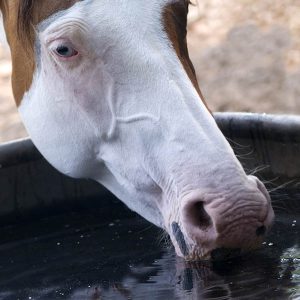
The Importance of Hydration
Interesting fact: Water makes up about 65% of a mature horse’s body weight. For a 15.2-hand, 1,000-pound horse, that amounts to 650 pounds or 85 gallons of water!
In order to maintain proper hydration, horses must drink significant quantities of water. In a cool environment, an inactive horse may drink around seven to 10 gallons daily. In a hot or humid environment, however, a horse might drink more than 20 gallons of water a day. This is precisely why some conscientious owners hang more than one bucket in a stall; they realize some horses are enthusiastic drinkers.
Exercise increases the need for water because of fluid losses incurred through sweating. Dehydration occurs when fluid losses exceed fluid intake, and sweating is responsible for most fluid losses during exercise. Loss of fluid can be staggering in some equine athletes: a racehorse can lose up to three gallons of sweat during a routine workout, and an endurance horse can lose six to eight gallons during a competition ride. For a typical 900-pound endurance horse, that means he could lose more than 10% of his total water reserves.
The majority of the fluid lost is pulled from the circulating blood volume, and this has dire consequences for the horse: inadequate blood supply to tissues, inefficient delivery of oxygen and energy sources to working muscles, and elevated heart rate during exercise, all of which can lead to fatigue.
Giving horses ample opportunity to drink during long schooling sessions and multiphase competitions is the best way to maintain hydration. There are times, though, when this is not possible. If you suspect that your horse is becoming dehydrated, there are two simple tests that you can perform. The first is the skin-pinch test, and it involves pinching the skin near the point of the shoulder. If the skin snaps quickly back into place, the horse is sufficiently hydrated. In cases of moderate dehydration, the skin may stay tented for two to four seconds, and in severe dehydration, the skin will remain lifted from the flesh for four to six seconds.
Capillary refill time (CRT) is another method of assessing hydration. CRT is evaluated by pressing a finger or thumb on the upper gum, above an incisor, for a second or two. Upon removal of your finger, the pressure point will be blanched. If the color returns to the gum in one to two seconds, the horse is amply hydrated. If it takes longer than two seconds for the color to reappear, the horse is likely dehydrated.
It’s a good idea to practice these techniques when you know your horse is healthy and well hydrated. That way, you will know what is normal for your horse and will be able to observe differences in skin tone and CRT readily.
Coinciding with severe fluid loss is electrolyte depletion. Electrolytes are released from the body in sweat. For optimal health and performance, those electrolytes must be returned to the body, preferably in the same ratio in which they were lost. The most efficient way to accomplish this is through a well-formulated electrolyte supplement. Research indicates that a properly balanced electrolyte contains a 1:2:4 ratio of potassium, sodium, and chloride, respectively.
Adequate water intake and electrolyte supplementation will ensure that equine athletes remain properly hydrated, which increases their ability to perform their best.


